Our Theme “A Pinoy State of Mind: Building with Our Roots” was chosen because we wanted to recognize that as Filipino Americans become more visible and successful across all sectors (e.g., academia, arts and entertainment, law and government, etc.) that we always remember where we came from, as well as the struggles of those who came before us.
– Kevin L. Nadal, PhD, FANHS National Trustee, FANHS 2016 Conference Coordinator, Associate Professor, John Jay College of Criminal Justice, CUNY
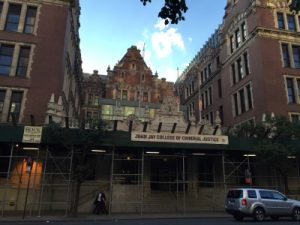
The Filipino American National Historical Society (FANHS) celebrated its 16th Biennial Conference, June 22-25, in New York at the John Jay College of Criminal Justice (524 W 59th St, New York, NY 10019). While I have been a member of the Stockton chapter of FANHS since 2004 (I joined the East Bay chapter in 2015), this was my first FANHS conference. I heard one of the FANHS National trustees declare that this conference was the best ever – and she’s attended all 16 of them – so I think I picked the best one to attend as my first. It didn’t hurt that the venue was in my favorite city in the country.

My oldest sister, Heidi, met up with me in New York, after my family went back home following a week of being tourists. My sister isn’t a member of FANHS, but she was intrigued by the various sessions being offered with such topics as genealogy, Filipinos in the military, oral histories, the Filipino Food Movement, cultural and historical preservation, WWII and Vietnam veterans, storytelling, and advocacy and organizing. We didn’t join the bus tour Wednesday afternoon that took conference attendees to various landmarks around the city, but I do regret not learning more about Filipino Americans in New York and seeing where Jose Rizal stayed during his visit in 1888 and where authors Jose Garcia Villa and Carlos Bulosan stayed when they came here. That Wednesday evening, the conference began with an opening reception and singing, dancing, and dramatic interpretation performances, all showcasing the vast talent of Filipino Americans in New York.
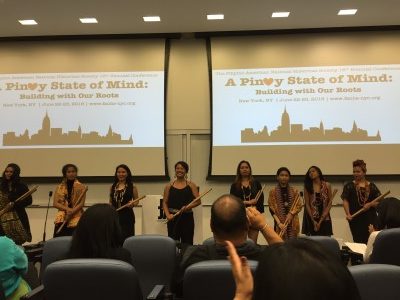

Telling our stories
Thursday morning, FANHS 2016 Conference Coordinator Kevin Nadal gave a warm welcome and was followed by Broadway actress (“Here Lies Love,” “School of Rock”) Jaygee Macapugay’s spirited rendition of Alicia Keys’ Empire State of Mind, an ode to the city that never sleeps. The opening panel featured Dorothy Laigo Cordova, founder and executive director of FANHS, and Ambassador Mario Lopez de Leon, Jr., Philippine Consul General to New York.
One of the themes that this panel stressed was the importance of telling our stories. They entreated us to tell our stories to other immigrants and other groups. We must “make our numbers count” and realize that we do matter and that we can influence what’s happening to us and around us. Ambassador Lopez de Leon, Jr. instructed us to “make our presence felt.” He concluded, “We have excelled. Our next step is to assume a position of influence and leadership.”

Nadal moderated the next session, the opening Plenary appropriately titled “A Pinoyorker Renaissance,” which featured Joe Bataan, King of Latin Soul; Ernabel Demillo, four-time Emmy nominated journalist and television news reporter who used to work in Sacramento; Rachelle Ocampo, host of Makilala TV Health; and DJ Neil Armstrong, Jay-Z’s tour DJ and President Obama’s Inauguration DJ. While I knew who Joe Bataan – Afro Filipino King of Latin Soul, originator of the New York Latin Soul style that fuses Latin-African beats with Soul and Doo wop – was, I had never heard his music. He related that he grew up in Spanish Harlem, got in trouble at an early age, and then had an epiphany that he had better do something with his life before it spiraled out of control. He got involved in music and he’s been entertaining audiences and serving as mentor to many musicians for decades. He is an inductee into the Musicians Hall of Fame, a recent inductee into the Smithsonian Institute, and his portrait was unveiled in The National Portrait Gallery in Washington, D.C., in October 2013. I was honored to hear and see him.
On a personal note, I have to say that I was relieved to hear Ocampo and Demillo openly admit that they don’t know the language, although Rachelle is taking Tagalog lessons. It’s interesting to learn that while, through the years, the older generation berated my sisters and me for not knowing the language, the practice of our first-generation parents not teaching their native language – Ilocano, Tagalog, Visayan, etc. – to their children, was widespread. Therefore, our parents and many first-generation parents either were pressured by society or concluded on their own that assimilation would prevent their children from facing discrimination and was the path to surviving and thriving in their new country. Unfortunately, our parents and the first generation didn’t realize that assimilation meant for some or many the subtle or outright rejection of one’s heritage and ethnicity. It’s really up to the second and succeeding generations to embrace their heritage and continue to pass on that love and appreciation.



History lessons of the Philippine Revolution
I was most interested in the Thursday morning session on “Revisiting Aguinaldo, Rizal, Bonifacio and Antonio Luna: A Filipino American Perspective,” which was led by Oscar Peneranda, well-known San Francisco Bay Area writer, educator, and activist, and Tony Santa Ana, community organizer, artist, and educator at De Anza Community College in the San Francisco Bay Area. For those who don’t know these names in the title session, they are national heroes and figures who contributed to the fight for freedom from Spanish rule.
What I appreciated the most was the fact that those who attended were knowledgeable about these Filipino leaders and engaged in a spirited discussion about the Philippine-American War, which is the subject of my second novel-in-progress. Among the things I learned is that the U.S. Bureau of Printing published a book of surveys and maps that the Navy had completed in the 1840s, which is evidence, according to one academic in attendance, that the United States had its eyes on the Philippines decades before events in 1898 led to the Philippine-American War. The Philippines, as someone pointed out, was a victim of geography because it was seen as the gateway to the rich markets in China. As you can imagine, I took many notes and picked up a handful of business cards.


Defining what is American
Thursday afternoon, before Jose Antonio Vargas took the podium as Thursday’s keynote speaker, news broke out that the Supreme Court deadlocked – 4-4 – on reviving President Obama’s plan to prevent deportation of millions of undocumented immigrants and instead give them the right to work legally in the country. A tangential aside: Understand that this is a sad consequence of not allowing President Obama to appoint a justice for the seat vacant since Antonin Scalia passed away in mid-February. Vargas, who is a journalist, filmmaker, and immigration rights activist, won the Pulitzer Prize in 2008 and founded Define American, “a nonprofit media and culture organization that seeks to elevate the conversation around immigration and citizenship in America.” He is also the founder, editor, and publisher of #EmergingUS, “a digital platform that lives at the intersection of race, immigration, and identity in a multicultural America.” Vargas “came out” in 2011 when wrote about his experiences as an undocumented immigrant in the United States, and penned a front-cover article in the June 25, 2012, issue of Time magazine. He produced the documentary “Documented” and was nominated for an Emmy for his MTV documentary “White People.”

This is the first time I’ve heard him speak, and I was truly honored. Vargas is a courageous, impassioned, inspirational human being. Because of the freshness of the Supreme Court ruling announcement and his raw emotions, Vargas asked that no one in the audience stream or record his keynote. That said, he was in control of his emotions, even throwing out liberal doses of humor and sarcasm. No doubt bolstered by having to deal with the wrath of many anti-immigration foes – from politicians and policymakers to people on the street – he showed tremendous restraint and reason in the face of ignorance and hatred. He talked about lessons learned and observations of other movements – specifically gay marriage – and noted that we have to “change culture before we can change politics.” Vargas explained, “You have to change the culture in which people talk about issues.”
“It’s important to control and frame our own narrative,” he went on. Vargas was brimming with surprising statistics, such as 1 out of 7 Koreans in this country is undocumented. So it’s not an issue of undocumented workers from Mexico, as most people would assume. Multiple nationalities are under that umbrella. Therefore, we must all work together and not look at this issue as another immigrant group’s problem. We need to remind those who seek to build walls or fences or shut the gate that our country was founded by immigrants.
One of my favorite lines that he quoted was from his MTV film “White People”: “White is not a country.” I tweeted that because so many people in this country need to be reminded of that phenomenon that seems to be treated as fact in the U.S. Vargas is thick-skinned, which I admire greatly. He has faced this question so many times – “Why are you here? Why are there so many of you here?” He formulated a brilliant comeback: “We are here because you were there.”
His conclusion may well have been the call to action to us in the audience. Many of us – especially those of us who are second generation and beyond – are privileged in myriad ways. “With privilege comes responsibility,” Vargas pointed out. “What are you doing with yours?” While the ruling was a big blow, he emphasized, disappointment must lead to positive action.


Author, author: Immigrant stories around the country
Later in the afternoon, I participated in the second of two author panels. Metro New York chapter member (who grew up in the Sacramento area, I found out via my cousin Leila Eleccion Pereira) Brenda Gambol moderated the panels. The second panel featured four authors whose works shared a common theme – immigrant stories representing various parts of the country – California, Hawaii, Alaska, and Illinois. Dr. Patricia Rosarnio-DeGuzman Brown, psychologist, educator, researcher, and author, read from Filipinas: Voices from the Daughters and Descendants of Hawaii’s Plantation Era. Dr. Brown is a FANHS trustee and founder and executive administrator of FANHS Hawai’i State chapter. Victoria Santos, president of FANHS East Bay, co-authored a book with her 94-year-old mother, who lives in Chicago. Memoirs of a Manang: The Story of a Filipina American Pioneer chronicles Vicky’s mother’s life as an immigrant and activist in America. Lastly, FANHS Seattle Chapter member Robert Francis Flor, PhD, read from his recently published book of poems, Alaskero Memories, an ode to the Filipino Americans who worked in Alaska’s canneries and fisheries.


In the evening, we were treated to a panel discussing Mia Alvar and her New York Times best-selling book, In the Country, a collection of nine fictional short stories about the Filipino diaspora inspired by her own transnational experience. I had her sign my copy of her book and had our picture taken. Of course, excited, I tweeted that I was honored to meet her, and she was kind enough to tweet a similar sentiment. I’m looking forward to reading the rest of her stories. I am halfway through the collection. The first story, “The Contrabida,” is as unsettling a story as it is beautifully rendered. My favorite thus far is “Esmeralda,” in which Alvar beautifully captures the shock, surrealism and heartache of 9/11 told in the perfect-pitch second person point of view.
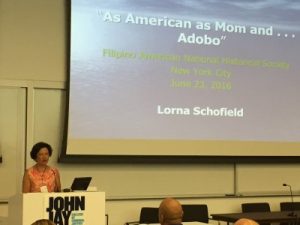
More notable Filipino Americans
Thursday was packed with what I felt like was a day-long star-studded program. Keynote speaker, the Honorable Lorna Schofield, holds the distinction of being the first Filipino American federal judge in U.S. history. Originally from Indiana, she is a U.S. District Judge for the U.S. District Court for the Southern District of New York. She received her JD from New York University School of Law and served as an assistant U.S. Attorney for the Southern District of New York, prosecuting domestic terrorism, smuggling, and tax fraud. Prior to her appointment in 2012, she was a partner in a law firm where she specialized in complex civil litigation and white-collar criminal defense. One interesting story Schofield shared with us was of her mother wanting her to assimilate: while her Filipina mother ate rice, she made variations on the potato for her daughter. Schofield certainly was driven and I appreciated her articulateness and her direct, no-nonsense sensibility. We are lucky to have her represent us in the federal judicial system. One hopes that there are others in the pipeline.
Fashion show highlights Filipino American designers
Thursday evening’s fashion show kicked off with members of FANHS chapters, including San Francisco chapter’s own Jason Agpaoa, interpreting their version of Filipino and Filipino American fashion style. Veejay Floresca, “islandwear” fashion designer Twinkle Ferraren, and Rafé Totengco, award-winning fashion designer and owner of his namesake handbag collection Rafé New York and creative director for handbags with the Nine West Group Inc., served as guest judges. The main contest featured designs by Iris Gil Vilacrusis, John Soriano, Katrina Delantar, Maria Velez, and Stephanie Gancayco. I didn’t keep track of who designed what, but my favorites were the two accessories designers – one who designed purses and the other who designed necklaces and matching purses. Although all had pieces that I found beautiful and would certainly have proudly worn, the accessories designer whose intricate necklaces and matching purses – made with organic fibers – won. It was a treat to see these designers incorporate natural materials and interpret Filipino traditional style in their designs.


I attended the session “Language, Labor, and Longing: Three Fulbright Experiences in the Philippines,” in which, as the title reveals, three academics shared their experiences in the Philippines as Fulbright scholars. Jason Reblando, photographer and artist based in Chicago and teaches photography at Illinois State University, exhibited his photographs. He captured the images of Filipinas who work overseas and congregate in the financial district in Hong Kong on Sundays, as well as a town filled with homes mirroring Italian architecture, which reflected the world of the Filipino overseas workers who work in Italy and return home to take care of their families. Grace Talusan, essayist and fiction writer who teaches writing at Grub Street and Tufts University, spent her time connecting with her heritage. Joseph Legaspi, co-founder of Kundiman, a nonprofit organization serving Asian American literature and poetry, talked about the process of applying for a Fulbright, which appears to be a lengthy, complex, and arduous process. Still, the presenters certainly gained so much personally and professionally from their stay in the Philippines.
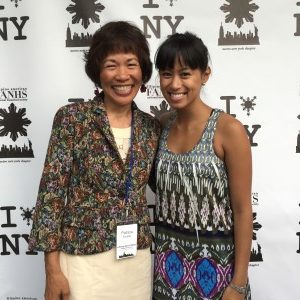
‘Filipino Americans making waves in mainstream’
One of the wonderful gifts of the conference’s location in New York is the ability to invite local high-profile Filipino-American leaders who represent so many different industries to be on panels. “Filipino Americans making waves in mainstream” featured those who have established themselves in their respective fields. Karla Garcia, New York City-based performer, choreographer, and teacher is currently in “Hamilton: A New American Musical,” which chronicles the life of American Founding Father Alexander Hamilton, with music and lyrics by Lin-Manual Miranda. The musical was nominated for a record-setting 16 Tony Awards – of which it won 11 – and won the 2016 Pulitzer Prize for Drama and the 2016 Grammy Award for Best Musical Theater Album. Garcia explained how as a “swing” she has had to learn thus far four of the five parts she was given, including the 50 songs written for the musical. The hardest part, she revealed, was remembering where to pick up and where to leave props on stage.
The millennial Matt Ortile started out in the Editorial Fellowship Program, Buzzfeed’s boot camp, after moving to New York. Ortile, who was raised in Manila, worked his way up to Editor of Buzzfeed Philippines, whose properties boast some 300,000 followers and is quite influential not just among Filipinos in the homeland but Filipinos around the world.

Jhett Tolentino, one-half of JoanJhett Productions and three-time Tony Award winning Broadway producer, is only the third Filipino to have won a Tony and the first Filipino Tony Awards voter. He won for co-producing “Vanya and Sonia and Masha and Spike,” the 2013 Tony winner for Best Play. In 2014, he won for co-producing “A Raisin in the Sun,” which starred Denzel Washington, as well as “Gentleman’s Guide.” Tolentino, who was born and raised in the Philippines, shared with us that he was an accountant who loved going to the theater and talking about it with his friends after the show. Upon his friends’ advice, he ran with his passion and became a critic, seeing more than 1,700 plays. His acumen as accountant served him well when he transitioned to producer. He was one of the producers of “Here Lies Love,” a rock musical about Imelda Marcos’s life and adapted from a concept album collaboration between David Byrne and Fatboy Slim. It was inspiring to hear him talk about not just following his true passion, but leveraging all his skills to become a successful producer, who, as he explained, wears many hats. After the session, I was able to meet and chat with all three, which was a treat for starstruck me.
Shining a light on little-known historical events in the Philippines
On Saturday, I attended the session “Forgotten Philippine and Filipino American History.” Sharon Delmendo, PhD, professor of English at St. John Fisher College in Rochester, NY, gave a presentation based on her research, “In Time of Need, an Open Door: Holocaust Rescue in the Philippines,” which looks at how Manuel Quezon welcomed some 1,300-plus Jewish refugees to the Philippines before World War II. “When the Time of Need Came: Manuel Quezon and Holocaust Rescue in the Philippines,” is a scholarly analysis of Commonwealth President Manuel Quezon’s efforts on behalf of Jewish refugees that is geared for the general public. Delmendo pointed out that local newspapers in the Philippines were reporting on Kristallnacht, the wave of violent anti-Jewish pogroms that swept through Nazi Germany in November 1938, and other atrocities, so Filipinos were well aware of the persecution of Jewish people. Quezon inserted a mandate on the promotion of social justice in the Philippines’ constitution, and that constituted the first of many instances of the Philippines stepping up and welcoming refugees who they were being driven out of their homeland, according to Delmendo. I never knew about the Holocaust Rescue in the Philippines, so all this was fascinating to me, although one elder academic attendee pronounced that Filipinos are inherently and historically racist, which made for an interesting discussion on racist Philippines versus immigrant-friendly Philippines. Someone brought up the fact that the combined Spanish and American colonial rule lasting hundreds of years certainly played a big role in instilling racism on the islands.
Jeffrey Acosta, founding member of the FANHS Hampton Roads chapter and adjunct instructor of U.S. History at Tidewater Community College in Norfolk, Va., told the story of the Buffalo Soldiers who fought in the Philippine-American War, 1898-1902. In July 1899, the U.S. 25th Infantry Regiment was one of the first “colored” units to arrive in the Philippines to combat the First Philippine Republic, according to Acosta. He talked about the internal and external conflict that these soldiers endured, facing discrimination at home and relating to the Filipinos who were being similarly mistreated by racist American soldiers and political leaders. Trying to bring the story of the Buffalo Soldiers to a wider audience has been taken up by others, including FANHS East Bay emeritus president Evangeline Buell and Bay Area filmmakers. Actor Danny Glover, who also starred in the television movie, The Buffalo Soldiers, is lending support for a documentary that is in pre-production about the soldiers and their service in the Philippines.
Raymund Liongson, associate professor and coordinator of the Philippine/Asian Studies program at the University of Hawaii-Leeward, talked about the abuses he experienced for his opposition views against the Marcos regime, and Elissa Ortiz added her own anecdotes. I appreciated the speakers sharing information and their research about these different periods in the Philippines’ history.

New York, New York
The final event of this fabulous conference was the FANHS Gala on the Hornblower ship, which featured dancing to the music of Joe Bataan and his band, dancing with actor and singer Paolo Montalbán, and hearing the inspiring words of hostess Geena Rocero, supermodel/TV host, activist and founder of Gender Proud. Previously, I didn’t know anything about Rocero, but I learned that her Ted Talk “Why I Must Come Out” was viewed more than 2 million times in just a few months. It was great talking with FANHS members whom my sister and I met at the conference. The biggest star, however, was the New York skyline and the Statue of Liberty – all beautifully lit up – as the boat gave us a breathtaking tour of the Hudson River. It was the perfect ending to a really wonderful conference.




If there was one complaint that I had about the conference, it is two-fold but under the same theme. This was the first conference to hold a Filipino American film festival, which was put together by a team that included Emmy Award-winning filmmaker and friend, Marissa Aroy, whose documentary, Delano Manongs: The Forgotten Heroes of the United Farm Workers Movement, shines a light on Filipino American contributions to California’s farm labor movement. However, it ran concurrently all-day Thursday, which meant if you took in the sessions and keynote speaker sessions, you missed out on the films, which is what happened to me. There were some 60 education sessions in all spread across three days. I had to prioritize, and a few times I missed an interesting session in favor of another one. But I guess that’s a good problem to have.
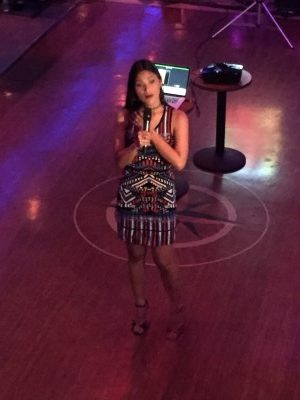




My first FANHS biennial conference was magical, educational, and inspirational. I was in awe of the talent across so many areas in my Filipino American community. And I fell in love with New York all over again. As Alicia Keys aptly wrote and belted out: “New York, concrete jungle where dreams are made of/There’s nothing you can’t do/Now you’re in New York/These streets will make you feel brand new/Big lights will inspire you/Hear it for New York, New York, New York.” Then again, FANHS announced that FANHS2018 will be held in another one of my favorite cities – Chicago. While I’ll be surely going, the work now and ongoing will be all about telling our stories, advocating for so many causes impacting Filipino Americans, and remembering and honoring our pinoy/pinay roots.


